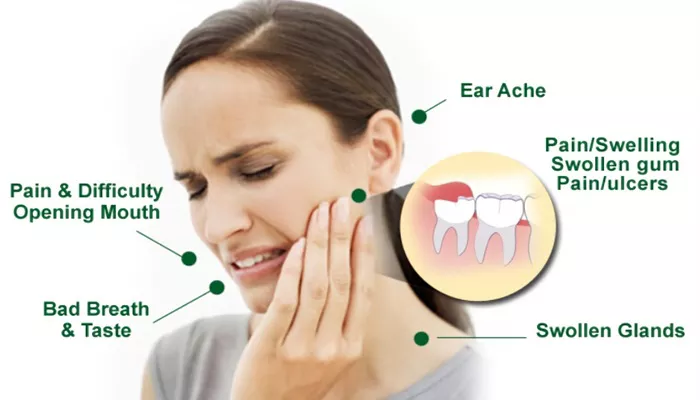Wisdom teeth, or third molars, are the last set of teeth to erupt in the mouth, usually between ages 17 and 25. Because they appear late and often have limited space, they can cause various dental issues, including pain.
Why Wisdom Teeth Can Cause Discomfort
Pain around wisdom teeth often stems from their position or complications during eruption. When there is not enough room in the jaw, wisdom teeth may become impacted, partially erupted, or misaligned, causing discomfort.
Reasons Why Only One Side of Wisdom Teeth May Hurt
Localized Infection: Pericoronitis
Pericoronitis is a common cause of pain on one side near a wisdom tooth. It occurs when the gum tissue around a partially erupted wisdom tooth becomes inflamed and infected. This infection often causes localized swelling, redness, and pain limited to the affected side.
Impaction and Pressure on Adjacent Teeth
If a wisdom tooth is impacted on one side, it may push against the second molar, causing pressure and pain. This pressure can irritate the tooth’s nerves and surrounding tissues, leading to pain that is only felt on the affected side.
Root Canal Issues
Sometimes, pain on one side may be due to infection or inflammation of the tooth’s pulp, requiring a root canal treatment. Wisdom teeth or adjacent molars can develop deep decay or trauma that triggers nerve pain confined to one side of the mouth.
Gum Disease or Gum Inflammation
Gum inflammation or early-stage gum disease around a wisdom tooth on one side can cause pain and discomfort localized to that side. Bacteria trapped around the wisdom tooth may lead to gum swelling and tenderness.
Other Dental Conditions That Cause One-Sided Wisdom Tooth Pain
Cavities or Tooth Decay
Decay in a single wisdom tooth or nearby molars on one side can lead to localized pain. Cavities expose the sensitive inner layers of the tooth, causing discomfort when chewing or exposure to hot or cold substances.
Abscess Formation
An abscess is a collection of pus due to bacterial infection. It can develop near a wisdom tooth or adjacent teeth and cause severe, throbbing pain on the affected side. Abscesses require immediate dental treatment to prevent spreading infection.
Jaw Joint (TMJ) Disorders
Temporomandibular joint problems can sometimes cause pain that mimics wisdom tooth pain but is usually limited to one side of the jaw. This pain can worsen with jaw movement or chewing and should be differentiated from tooth-related pain.
When to See a Dentist About One-Sided Wisdom Tooth Pain
Signs That Require Immediate Attention
If pain is accompanied by swelling, fever, difficulty opening the mouth, or spreading redness, it may indicate a serious infection like pericoronitis or an abscess. Immediate dental consultation is necessary to prevent complications.
Persistent or Recurrent Pain
Any ongoing or repeated pain on one side around wisdom teeth should be evaluated. Early diagnosis can prevent worsening problems such as gum disease, root canal infections, or damage to adjacent teeth.
Treatment Options for One-Sided Wisdom Teeth Pain
Antibiotics and Pain Management
For infections like pericoronitis, dentists often prescribe antibiotics to control the bacterial infection along with pain relievers to reduce discomfort. Proper medication helps manage symptoms before more definitive treatment.
Dental Cleaning and Gum Care
Professional cleaning around the wisdom tooth can remove trapped bacteria and debris that cause gum inflammation. Maintaining excellent oral hygiene is essential to reduce gum disease and inflammation on the painful side.
Root Canal Treatment
If pain arises from pulp infection or nerve damage, root canal therapy can save the tooth by removing infected tissue and sealing the tooth. This treatment targets the source of pain and preserves the tooth structure.
Wisdom Teeth Extraction
Extraction is a common solution for problematic wisdom teeth causing one-sided pain. Removing the tooth eliminates the source of infection, impaction, or decay, thereby resolving pain and preventing future issues.
How to Prevent One-Sided Wisdom Teeth Pain
Regular Dental Check-Ups
Routine dental visits allow early detection of wisdom teeth problems before pain develops. Dentists can monitor eruption patterns, gum health, and tooth alignment to decide if preventive extraction is necessary.
Good Oral Hygiene Practices
Brushing twice daily, flossing, and using antibacterial mouth rinses help reduce bacterial buildup around wisdom teeth. This lowers the risk of pericoronitis and gum inflammation that often cause one-sided pain.
Avoiding Irritants
Avoiding smoking, excessive sugary foods, and poor oral habits can protect gums and teeth from infections and decay. These habits especially help maintain health around wisdom teeth, reducing chances of localized pain.
Conclusion
One-sided wisdom teeth pain is a common dental complaint caused by several factors including pericoronitis, root canal infections, gum disease, and impaction. Because wisdom teeth are prone to infection and difficult to clean, problems often begin on just one side. Timely dental evaluation and treatment are essential to relieve pain, prevent complications, and maintain overall oral health. Proper hygiene and regular dental check-ups help reduce the risk of one-sided wisdom tooth pain.

